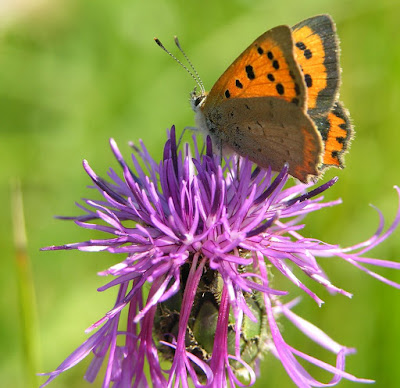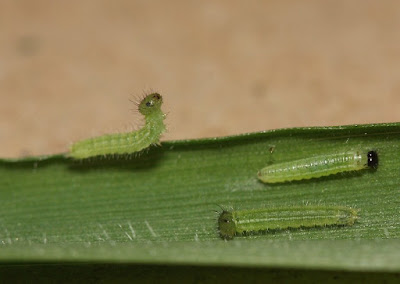 |
| Primroses are a good source of nectar for insects. Photo: Wikipedia |
Pollen and Nectar - Spring
We need pollinating insects for many of our food crops. Insects coming out of hibernation need food. For many, that food is nectar for energy and pollen for protein to make their eggs and feed their young. Look around your garden and neighbourhood: are there flowers around to supply their food? Are there bees, hoverflies, butterflies feeding in your garden? If not, maybe you could plant suitable flowers in your garden. Think primroses and cowslips, creeping comfrey, honesty. Include tree fruit and soft fruit, which need the pollinators to yield a good crop. Also spring-flowering shrubs such as hawthorn and cotoneasters. Remember to avoid double varieties, which often lack pollen.
 |
| Create a log pile to provide shelter for invertebrates. Photo: Andy Roberts, Flickr |
Shelter
Our climate is famously variable. Most invertebrates need somewhere to hibernate in winter. Even in summer a wet day can mean butterflies, bees, hoverflies and other creatures need somewhere to hide from the rain. Look round your garden – are there places to shelter? Maybe a dense hedge or group of shrubs, a loose pile of large stones or bricks, or a ‘log-pile’ of larger prunings. Dead leaves heaped in a corner are useful to some species, as are tussocks of unmown grasses such as cocksfoot. If space is limited, how about an evergreen climber up a wall or fence.
 |
| Small copper butterfly on knapweed flower. Photo: Giles Watson, Flickr |
Helping Breeding Butterflies
Many of us like to see butterflies in our gardens – except those who grow cabbages! Most gardens can provide food (nectar) and shelter for adult butterflies. Adults (the flying stage) will take nectar from a range of flowers, so long as the nectar is available to their long tongues. Open flat flowers are favourites – think Daisy family (aster, dandelion, knapweed, coneflower, fleabane); the hardy Geraniums; Carrot family (fennel, Eryngium), Mint family (lavender, marjoram). The key thing is to have flowers all season from March to September, so whenever the adults fly there is something to eat. You may not be able to supply that in your own garden, but remember these are flying insects, so look what it in the neighbourhood and try to fill any gaps.
 |
| Speckled wood caterpillars. Photo: Dean Morley, Flickr |
Provide Food For Caterpillars
Butterflies are very choosy creatures – each species has only one or two food plants which their caterpillars will eat. Not many of these can be grown in the average garden, but one species that often thrives in groups of gardens in Holly Blue. Look for small pieces of blue sky flying head-height and above in spring and late summer. The April-May generation lays eggs on female holly bushes, so the caterpillars can feed on the flowers and developing fruits. The August generation lays on ivy to take advantage of their flowers and fruits. So look around, is there flowering holly and ivy in reach? If not, could you plant some? Ivy rarely needs planting, but could you tolerate some climbing up a fence or wall (it needs to climb to flower)? Dense ivy also makes good shelter and hibernation places.
Several of our butterflies breed on stinging nettles (small tortoiseshell, peacock, red admiral and comma), but they are choosy creatures – they insist on sunny nettle beds. There is plenty of stinging nettle in most landscapes, even urban ones, so unless you have a very large garden, you probably have better uses for a sunny corner than a stinging nettle bed – plant herbs and other nectar-rich plants there instead. Nettles in shade are used by some moths – we have mother-of-pearl and nettle-tap at New Ferry Butterfly Park. The caterpillars roll up a leaf and secure it with silk to make a shelter against being eaten by birds. Look for the rolled-up leaves in June on your local nettle patch.
If you can leave an area of your lawn to grow long, cutting it down only in autumn, then you might be lucky enough to get one of the butterflies whose caterpillars eat grasses. At my allotment set, we have a border along the access path which is a mix of nectar-producing flowers and, because we never manage to keep it too tidy, some clumps of grasses. Also a small wildlife area in one corner, with a pond, large log-pile for shelter, stinging nettles and rough grass. Speckled wood butterflies have taken up residence in recent years – their caterpillars like semi-shaded grasses, mainly Yorkshire fog and Cock’s-foot, which are grasses that grow on fertile garden soils. And yes, we do have frogs breed in the pond (to eat our slugs) and small tortoiseshell butterflies breed on the nettles.
 |
| Leaf-cutter bee cutting a circle from a leaf, which it takes back to its nest to use to build cells to lay eggs in. Photo: The Guardian |
Please Don't Use Pesticides Or Peat
Insect populations have dropped drastically in the last 50 years – some studies say the amount of flying insects has dropped by 75%! This impacts us (they pollinate our crops and process dead plants and animals), and all animals that feed on insects (birds, bats, spiders, etc). So we all need to help our insect friends where we can. So please, don’t use pesticides if you can possibly help it! In most gardens, they are unnecessary. Even herbicides such as glyphosate can have side-effects on insects, and no insecticide is specific to a given species, whatever the packaging claims. Tolerate a bit of damage – you are not Tatton flower show! Admire the perfect circles cut by leaf-cutter bees and the wiggle traces made by leaf miners on holly. Encourage predators such as spiders, earwigs, small birds – a pair of blue or great tits nesting in your garden will hoover up a lot of aphids and gooseberry sawfly caterpillars to feed their young. And please don’t use peat-based compost or buy plants grown in peat: peat bogs support specific rare insects like Large Heath butterflies, and are large stores of carbon, vital to the fight against climate change.
Dr Hilary Ash
Dr Hilary Ash

No comments:
Post a Comment